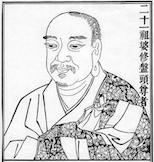Koso Wasan 12
The adornments of the Pure Land of peace
Are perceived only by the wisdom shared by the Buddhas.
That land is infinite, like space,
Vast and without bound.
The Jodo Ron

All of the verses about Vasubandhu (11 - 20) are inspired by the Amitayus Sutropadesa (Treatise on Amida Buddha), which, in Japanese is popularly known as Jodo Ron. Two verses are indirectly influenced by T'an-luan's commentary on the Jodo Ron. This is a very important document indeed because (or so it seems to me at any rate) although Nagarjuna delineated the 'difficult' and 'easy' paths, it was Vasubandhu who set the spiritual themes for the entire Pure Land tradition. His influence can be found throughout its history and, of course, in Shinran Shonin, whose strongest influence was clearly from T'an-luan's commentary on the Jodo Ron. The first character in Shinran's name comes from the second character of the Chinese reading of Vasubandhu (Jp. tenjin).
The Jodo Ron is concerned with the bodhisttava path and also 'turning of merit' (eko Sk. parinama). We will, at last, have a close look at parinama later in this group of verses. I believe, in fact, that parinama is grounded within an immutable truth of existence.
Although its author is famous for his seminal contribution to the Vijñaptimatrata philosophical tradition, this tradition of itself generally falls short in certain significant principles. For instance, its largest school did not accept the universality of Buddha nature. For this reason, one of its most famous exponents, the seventh century Chinese pilgrim Xuanzang, was haunted by the fear that he might not have Buddha nature until he had confirmation of it during his time in India.
On the other hand, it can be seen from the Jodo Ron that it is a typically Yogacara document because it is all about the practice of meditation as the way of realising birth in the Pure Land. Samatha (calming of the mind) and Vipasyana (insight) were inherited from the meditative practices of India long before the rise of Buddhism and its contemporary movement Jainism. Vasubandhu's instruction involves the completion of five stages of spiritual development. The first four stages are steps on the way to birth (in the Pure Land) and the final and fifth step is giving away the merit gained in the course of practice. Of the first four stages of mental training, the first three, worship, praise (saying the Buddha's Name) and desire for birth in Sukhavati are samatha; and vipasyana is contemplation of twenty-nine adornments in the Pure Land - of the Pure Land itself, Amida Buddha and the Bodhisattvas.
But Shinran and most of his predecessors were not at all concerned with this meditation practice, except to the extent that it is a natural (jinen) process that carries people of shinjin to buddhahood. Rather, the Jodo Ron has been seen as laying the foundation for certain key factors in the Pure Land path. We shall discover these in more detail, as we progress through the verses concerned with Vasubandhu.
As far as I can see, there are four enduring features which the Pure Land tradition took from the Jodo Ron. They are the opening lines of the verse which prefaces the discourse, the description of the Pure Land, the turning of merit and the grace or help that comes from the Power of the Vow of Amida Buddha. These four pillars, so to speak, of Pure Land theory became an integral part of the religious experience of Pure Land aspirants throughout history and are still living realities today. These considerations obviously contribute to the fact that even though saying the name (shomyo) became the principal practice in the Pure Land way by the time of Honen Shonin, the Jodo Ron of Vasubandhu remained the fourth book in the canon of basic scripture, the other three being the Three Pure Land Sutras.
The description of the Pure Land as
infinite, like space,
Vast and without bound.
reminds us that the Pure Land is nirvana, which - from the time of Shakyamuni Buddha and the earliest days - was seen as both a state of mind and a place. For those who awaken to Amida Buddha's shinjin, birth in the Pure Land and simultaneous realisation of nirvana occur at death, our birth having been settled with the realisation that we are 'embraced and not forsaken' by the compassion of the Buddha the moment shinjin arises in our hearts.